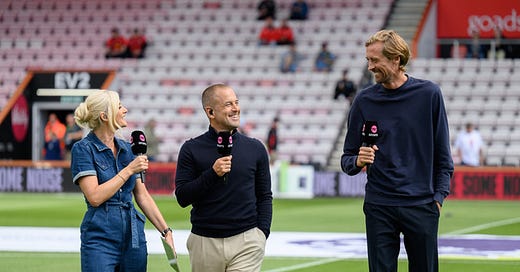Inside Access: The Premier League's New Broadcasting Era
What does greater media access mean for football's business, brands, and fans?
The landscape of football broadcasting is evolving, and next season will bring unprecedented access to the beautiful game. Broadcasters are in discussions with the Premier League and the FA about conducting live interviews with managers, coaches, and substituted players during matches. Rights-holders such as TNT Sports and Sky Sports are pushing for more behind-the-scenes coverage, including cameras inside dressing rooms. Brentford FC has expressed interest in this initiative, welcoming new content formats such as dressing room footage, TNT Sports pundits, and former players, Peter Crouch and Joe Cole training with their squad.
But what does this mean beyond entertainment? Let’s break it down.
A Shift for Football as a Business
Football is a media-driven industry, and the Premier League’s commercial dominance is tied to its broadcast deals. According to PA Media and Sports Pro, the league’s global and domestic commercial and broadcast revenue will rise by 17% to £12.25 billion for the 2025-2028 cycle. New broadcast initiatives like this will increase the commercial appeal of the league, solidifying its position as the most lucrative domestic football competition in the world.
By granting deeper access, the Premier League enhances the value of its product. More content means more engagement, and more engagement means bigger deals with sponsors, advertisers, and media partners. In an era where attention is currency, exclusive, real-time access is a goldmine.
Implications for Brands
For brands, this evolution presents a massive opportunity. The ability to integrate storytelling into real-time moments provides endless creative possibilities. Imagine a sports drink brand capturing a player rehydrating mid-game, or a fitness brand aligning itself with pre-match dressing room rituals. With this level of access, brands can create immersive campaigns that tie their products directly to the emotions and intensity of football.
Moreover, increased coverage means more inventory for ad placements and sponsorships. Whether it’s subtle product placements in the dressing room or on-screen graphics during real-time interviews, brands can align themselves with the game’s rawest moments, building deeper connections with audiences.
What This Means for Fan Engagement
At its core, football is about passion, drama, and human connection. The introduction of live manager interviews, substituted player insights, and dressing room footage will bring fans closer to the game than ever before. This is an era where authenticity is everything—fans crave unfiltered, behind-the-scenes content that makes them feel like they’re part of the action.
Hearing a manager’s tactical adjustments in real time, watching a substituted player’s reaction on the bench, or getting a peek at the emotional highs and lows in the dressing room—these are the moments that bridge the gap between fans and the game. Whether it’s witnessing a fiery halftime team talk or seeing the raw joy of victory, these access points create a more immersive and emotionally engaging experience for viewers.
The Bottom Line
This initiative isn’t just a minor tweak to football broadcasting—it’s a major development. By making the game more transparent and immersive, the Premier League is capitalising on the modern media landscape, where engagement and authenticity drive value.
For fans, this means unparalleled access to the game. For brands, it opens the door to more creative and impactful sponsorship opportunities. And for the football business as a whole, it solidifies the Premier League’s dominance as a global commercial powerhouse.
This shift will happen—it’s just a matter of how soon and to what extent. One thing is certain: the way we experience football is about to change.
.





Quality breakdown as always 🫡